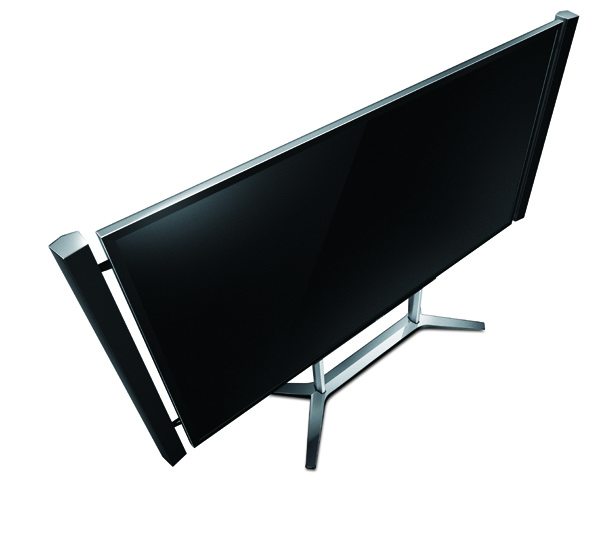Sony Bravia XBR-84X900 3D LCD Ultra HDTV Page 3

Sony’s opening orientation brief included comparisons of native 4K material and the same material in 2K, but upconverted by the set. They used two XBR-84X900s side by side, both in their Cinema 1 default settings. I guessed wrong as to which was which—and anticipated up front that my guess would be wrong! The simulated 4K looked very subtly sharper when I focused on the tiniest details in the picture. This was likely due to a little overeagerness in the upconversion algorithms, but it did not look edgy or processed.
After the briefing, we turned off all but one of the XBR-84X900s, and I was left on my own. In addition to the Sharpness and Reality Control settings described earlier, I turned the backlight control down to 2 for a peak 2D brightness of just over 37 foot-lamberts. The default backlight setting used in the briefing was 5 (maximum 10), producing a peak white level of 48.7 ft-L—too bright for my taste in a fully darkened room. I did most of my viewing at about 9 feet from the 84-inch screen, for a horizontal viewing angle of 37.4 degrees—about 2.6 screen heights, or 1.5 screen widths.
My calibrations, performed with 2K test patterns (no 4K patterns were available) translated well, subjectively, to the native 4K sources. The lack of a color management system was a downer, but the set could nevertheless be tweaked to adhere closely to the standard Rec. 709 HD color gamut. The color points were very close to correct, though a little work was needed to get the color brightness readings as close to the standard as possible. More on this in “HT Labs Measures.” Visually, the colors were never less than outstanding, with spot-on fleshtones and bright, natural hues in every source I watched.
On difficult, dark scenes, the XBR-84X900 produced solid blacks. They weren’t quite the equal of what we’ve seen on sets with full backlighting with local dimming, including Sony’s own XBR-55HX950, and they certainly weren’t up to the standard of my reference Pioneer Kuro plasma. But the dark interior scenes in Stargate Universe (a television series that’s a movable feast of dark scenes) were appropriately gloomy. Some of the exterior starfield shots looked a little gray, but others were fine. The brief starfield shots at the beginning of Prometheus (another black-level torture test), however, were more impressive, as were the shadow details in the dank and dim caverns on the menacing alien planet.
But it was the native 4K material from the server that really grabbed my attention. It was as naturally sharp as I could hope for, with an uncanny combination of detail and creamy smoothness, almost as if the regular HD pixel structure I’m used to on 2K displays was adding a subliminal graininess to the image that native 4K eliminates. If you get really close to the screen, you can see the very tiny pixels, and they were uniformly sharp from corner to corner and edge to edge.

I also sampled a number of Blu-ray Discs I brought with me, and as upconverted by the set, none of them disappointed. In fact, despite their 2K roots, they had enough of the 4K look to make me less concerned about the current shortage of native 4K source material. One of the movies on the Sony server was Battle: Los Angeles. I knew this ahead of time and brought the Blu-ray version for comparison. Once you locate a scene in this film without shaky-cam syndrome, it’s a sharp, crisp BD transfer. While this comparison was done by switching inputs, with a slight delay, on the same set rather than side by side on two sets, my earlier impression was reinforced: The upconversion of a good 2K source was very nearly indistinguishable from native 4K on this set. Longer comparisons than I had time for might qualify this conclusion, but I was impressed.
I was able to do a full 3D calibration, but the time I had for actually watching 3D was limited. Nevertheless, what I did watch looked spectacular. With a peak brightness around 23 ft-L, 3D popped off the Sony’s big screen in a way 3D rarely does even on much smaller sets. And the resolution, even though it was an upconversion from 2K 3D on Blu-ray and limited to 1080 lines vertical by the passive 3D process, was easily the most impressively sharp and detailed 3D I’ve yet experienced from a consumer display. It was so much fun to watch that I regretted not bringing more 3D discs apart from Avatar and Wreck-It Ralph. But they were more than enough to confirm the Sony’s impeccable 3D credentials.
Conclusions
How do you rate the value of a product that has limited competition in its market segment—even if the price is enough for a comfortable down payment on a house? You can’t, particularly if that product excels at what it does. Just how much of the Sony XBR-84X900’s outstanding performance—whether the source is 2K, 4K, or even 3D—is due to its native 4K, and how much can be credited to the extra margin the price gives for the designers to elevate every other aspect of the set’s design to a higher standard? We can’t say as yet for certain, but we can say that 4K certainly doesn’t hurt.
Yes, I would have preferred to spend several days with the set after calibration, as we usually do in our in-house reviews. Long-term viewing often turns up unexpected information that the eager flush of a first infatuation cannot. But the time I had was sufficient to raise covetousness to a steamy level, steamy enough to mandate a visit to a confessional ASAP. If only I had the space and the ready cash!

























































